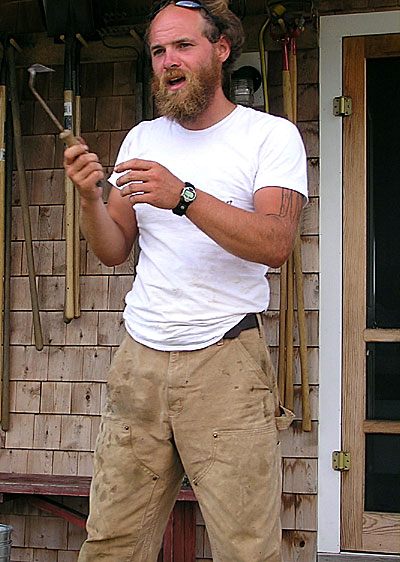 |
| Chris Cavendish, who was MOFGA’s farmer-in-residence at the time, talked about some of his favorite tools at the Small Farm Field Day in Unity last July. English photo. |
By Jean English
Chris Cavendish, who was MOFGA’s farmer-in-residence for the past two years, talked about his experiences growing crops in and out of a hoop house at MOFGA’s Small Farm Field Day in Unity on July 31, 2005, and highlighted some of his creative marketing techniques. Field Day participants offered input into management issues with hoop houses.
Cavendish strongly recommended Eliot Coleman’s Four Season Harvest and its supplement, The Winter Harvest Manual. Using these as guides for seeding dates, Cavendish had been planting carrots from mid- to late July for a fall harvest. He was beginning to plant spinach and would continue through mid-September. These crops would be sown outdoors, then the house was to be moved over them in late September or early October.
This 30- x 72-foot Harnois house rests on steel skids that are bent upward at the leading edge, like skis, so that it can be moved over the soil surface. Cavendish found that anchoring the house is important, since it shifted in the winter winds the previous year, rose up, and let cold air in. Chains anchor the greenhouse, from a steel rod with eyes in it at the top of the house, to bolts set in concrete in the ground.
Field Day participants talked about dealing with snow loads on plastic-covered houses. Cavendish wrapped used Reemay around a steel pole and poked the top of his house from inside to remove snow. Another put a plastic watering can on a pole. A third banked his house with hay bales, one bale deep; he was able to shovel snow off the bales, then run a snow blower alongside them. He thinks the bales helped reduce the shifting. Another participant said that heat from his house melted the snow, which then froze into a sold mass of ice. He learned to go out every day to remove snow. Yet another participant put straw bales along the inside and outside walls of his house.
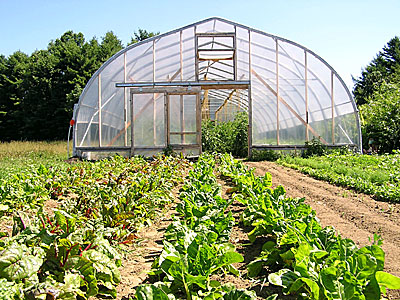 |
| This Harnois greenhouse covers carrots and spinach in cool weather and tomatoes, peppers and eggplant in warm weather. Moving the greenhouse can be labor- or machinery-intensive, but increases the area under plastic over the course of the year. English photo. |
Moving Houses
Moving these houses can present problems. Cavendish said that Coleman moves his with a bulldozer. The MOFGA house has been moved with a couple of tractors. Cavendish and three others tried together to use wenches, a hand crank (from farmtech.com) and 1/8-inch cable; he thinks a 3/16-inch cable might work better. Also, two of the four had to pry the front of each steel-rod base up to get the house to move, and the house lurched forward each time. The four people spent four hours moving the house 120 feet.
One Field Day participant recommended a chain-drive come-along (rather than a cable come-along) with a 24-foot chain. Cavendish thought that setting rollers (e.g., logs) under the house might help.
The doors of the MOFGA house are removed before the house is moved. Also, the lower panels are lifted so that they don’t catch on the soil; and a board across the bottom of the house keeps it from spreading. (This house has a door-within-a-door system. The smaller door is used for a person entering the house; the larger door slides to create an opening for a tractor.)
Despite the difficulty, Cavendish says that moving a $3,500 house to get an additional 2,000 square feet of growing space out of it is worthwhile for the starting grower, who may not be able to afford a second house. Moving the house also exposes the ground to rains and freezes, helping prevent salts and pests from building up.
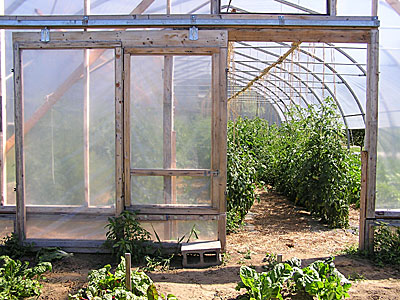 |
| The Harnois house has a door-within-a-door system. The smaller door is used for a person entering the house; the larger door slides to create an opening for a tractor. English photo. |
Another participant says he grows crops in raised beds in a house that he doesn’t move; he uses the bucket on his tractor to remove and replace the soil, adding horse manure below beds to help them heat. “If you can’t move a house or a crop, move the soil,” he said.
Planting Dates
Cavendish’s hoop house calendar is:
January – Add amendments to the soil in the house. Since compost stored outdoors will be frozen, he plans to build a mini hoop house over his compost. Plant carrots in some beds.
March – Plant spinach in remaining beds.
April – Move the house when the carrots and spinach no longer need protection. Start tomatoes in the house at its new site.
Mid-July through September – Plant carrots and spinach outdoors.
Late September or early October – When the tomatoes are finished, move the house over the carrots and spinach.
John Fromer of Appleton pointed out that home gardeners can use a smaller house to supply themselves with radishes, greens and kale in the winter. He also suggested that people who are interested in growing crops in greenhouses contact the University of Maine Cooperative Extension greenhouse specialist, Gleason Gray, through their local extension educator.
Regarding composting in winter, one grower said that he composts in pits that are 60 feet long, 3 feet deep and 8 feet wide. A half-dozen horizontal, perforated pipes between each layer of compost in the pits keep the compost aerated. (This wouldn’t suffice for certified growers, who are required to turn their piles.)
Hoop houses can also be used for starting seedlings for outdoors. Fromer suggested that gardeners can move a cold frame into the house to start seedlings there in the spring. Cavendish said he had put hoops over two benches, put plastic covers on the hoops, heated below the covers with a $15 fan/heater from TruValue, and his “tomato seedlings did great.” He’s experimenting with germinating onion seeds in cell trays or in flats at 40 degrees, without added heat (but possibly with a Reemay covering), in the hoop house. He uses a smaller greenhouse to dry onions in August; after they’re dry, the house becomes a warm place to clean fall vegetables.
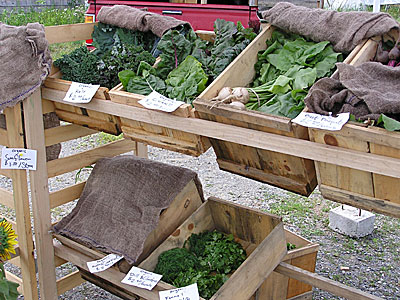 |
| Cavendish made a folding wooden frame that holds wooden boxes of produce for his stand at farmers’ markets. English photo. |
Marketing
Growing vegetables is one thing; marketing is another. Cavendish is creative with both. He’s planning to mix red, yellow and purple carrots in bunches, to get a higher price at the farmers’ market in Portland. He’s raising some 30 varieties of open-pollinated and hybrid tomatoes with the idea that he might become “the tomato kid” at the market. In offering seedlings at the market, he’s found that some people wanted heirloom tomato plants; others wanted container plants.
Cavendish says an attractive display with bountiful bins is important, as is a nice farm sign. His design features wooden crates that sit in a wooden frame that folds for transportation.
Check magazines for recipes, Cavendish advises; then you can tell your customers different ways to use your produce. Creating recipe cards could be a good winter project.
Get names and addresses from customers’ checks to create a mailing list. Use this to let people know when greens, radishes and other crops are available.
Invite people to your farm, and talk to lots of people to find out what they want – especially restaurant chefs – says Cavendish. You can also have business cards; and a scrap book featuring articles and photos of your farm. He makes shirts that encourage customers to talk to him. One reads, “Be still my weeding heart.”
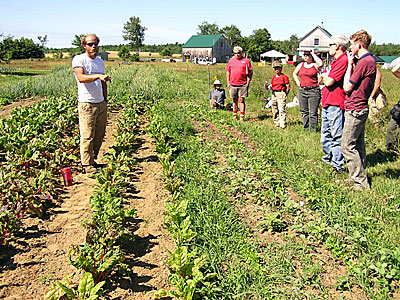 |
| Chris Cavendish at Farm Day. English photo. |
Resources
Byczynski, Lynn, The Hoophouse Handbook, growing produce and flowers in hoophouses and high tunnels, 2003. $15 (payable to Growing for Market) from Fairplains Publications, P.O. Box 3747, Lawrence, KS 66046; Tel. 1-800-307-8949; www.growingfor market.com.
Coleman, Eliot, The Winter-Harvest Manual, farming the back side of the calendar, 2001. $15 (payable to Four Season Farm) from Four Season Farm, 609 Weir Cove Rd., Harborside, ME 04642; www.fourseasonfarm.com. (This Web site lists further resources related to hoop houses.)
Farm-Tech Crop Services, P.O. Box 225, Highway 56 West, Adams, MN 55909; Tel. (507) 582-7725; www.farmtech.com
Greenhouse Supply Inc., 12 Acme Rd # 212, Brewer ME 04412. Tel. (207) 989-1585.
Griffin Greenhouse Supply, Gray, Maine; Tel: (207) 657-5442 — www.griffins.com
Harnois Greenhouses, Les Industries Harnois Inc. 1044, rue Principale St-Thomas-de-Joliette, QC J0K 3L0; Tel: 1-888-HARNOIS (1-888-427-6647); www.harnois.com. (Greenhouse Supply in Brewer carries Harnois houses.)
Person, Ed, Ledgewood Farm Greenhouse Frames, RFD 1, Box 375, Moultonboro NH 03254; Tel. (603)-476-8829
